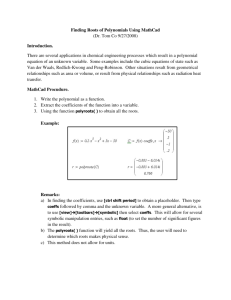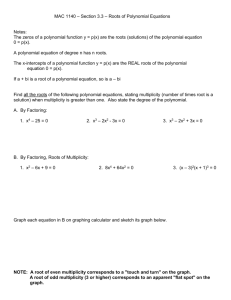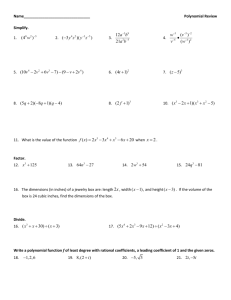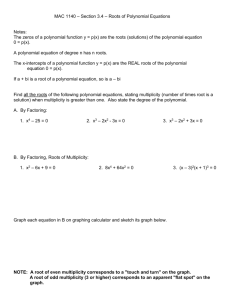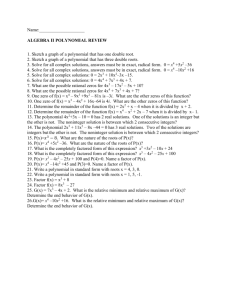Chapter 11 Polynomial Functions
advertisement
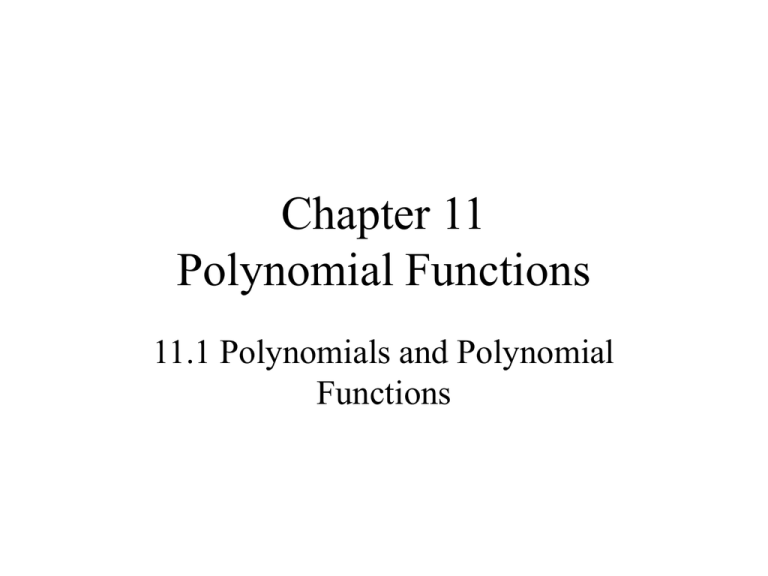
Chapter 11 Polynomial Functions 11.1 Polynomials and Polynomial Functions Chapter 11 Polynomial Functions 11.1 Polynomials and Polynomial Functions A polynomial function is a function of the form f(x) = an x nn + an – 1 x nn – 11 +· · ·+ a 1 x + aa00 Where ann 00 and the exponents are all whole numbers. For this polynomial function, aan is the leading coefficient, coefficient n aa00 is the constant constant term, term and n is the degree. degree A polynomial function is in standard form if its terms are descending order order of of exponents exponents from from left left to to right. right. written in descending Objective: Determine whether a number is a root or zero of a given equation or function. Objective: Determine whether a number is a root or zero of a given equation or function. Objective: Determine whether a number is a root or zero of a given equation or function. Objective: Determine whether one polynomial is a factor of another by division. Objective: Determine whether one polynomial is a factor of another by division. Objective: Determine whether one polynomial is a factor of another by division. HW #11.1 Pg 483-484 1-21 Odd, 22-31, 35-36 Chapter 11 Polynomial Functions 11.2 Factor and Remainder Theorems P(10) is the remainder when P(x) is divided by x - 10. P(10) = 73,120 P(-8) = -37, 292 Find P( -4) Yes No Yes We look for linear factors of the form x - r. Let us try x - 1. We know that x - 1 is not a factor of P(x). We try x + 1. To solve the equation P(x) = 0, we use the principle of zero products. P(x) = (x – 2)(x + 3)(x + 5) x = 2 x = -3 x = -5 f ( x ) D( x )Q( x ) R f ( x ) ( x 1)Q( x ) 0 f ( 1) ( 1 1)Q( 1) 0 ( 1)7 a( 1) 2 0 a 3 f ( x ) x 7 3x 2 f (2) 27 3(2) 2 120 x 3 3x 2 bx 5 ( x 2 )Q( x ) 1 23 3(22 ) b(2) 5 (2 2)Q(2) 1 b 12 4. Solve -5 < x< 1 or 2 < x < 3 HW #11.2 Pg 488-489 1-15 Odd, 16-31 Chapter 11 11.3 Theorems about Roots Carl Friedrich Gauss was one of the great mathematicians of all time. He contributed to many branches of mathematics and science, including non-Euclidean geometry and curvature of surfaces (later used in Einstein's theory of relativity). In 1798, at the age of 20, Gauss proved the fundamental theorem of algebra. If a factor (x - r) occurs k times, we say that r is a root of multiplicity k Where in the ____ did that come from? The polynomial has 5 linear factors and 5 roots. The root 2 occurs 3 times, however, so we say that the root 2 has a multiplicity of 3. -7 Multiplicity 2 4 Multiplicity 2 1 Multiplicity 1 3 Multiplicity 1 3 Multiplicity 2 -1 Multiplicity 1 Degree 3 3 roots x9 x 3 4i x 3 4i Complex Roots Occur in Conjugate Pairs Irrational Roots also come in Conjugate Pairs Degree 6 6 roots x 2 5i x 2 5i x i xi x 1 3 x 1 3 7 2i and 3 7 5 Degree 4 4 roots 2i -2i 1. Divide p(x) by a known root to reduce it to a polynomial of lesser degree 2. Divide the result by a different known root to reduce the degree again 3. Repeat Steps 1 and 2 until you have reduced it to degree 2, then factor or use the quadratic formula to find the remaining roots Roots are 2i, -2i, 2, and 3. i, i, 2, 1 x 2 ( x 2) is a factor x 1 ( x 1) is a factor x 3i ( x 3i) is a factor Let an = 1. The number an can be any nonzero number. We proceed as in Example 6, letting an = 1 x 0 x is a factor x 1 ( x 1) is a factor x 4 ( x 4) is a factor Degree 5 5 roots Multiplicity 3 means it is a factor 3 times f ) p( x) x3 6 x 2 3x 10 g ) p( x) x5 6 x 4 12 x3 8x 2 x 1 2 x 1 2 is a root x 1 3i x 1 3i is a root h) p( x) x 4 6 x3 11x 2 10 x 2 i ) p ( x) x 3 2 x 2 4 x 8 HW #11.3 Pg 494-495 1-49 Odd, 59 3 4 No No p( x ) 2 x( x (3 4i ))( x (3 4i )) p( x ) 2( x 1)( x 2)( x ( 2 i ))( x ( 2 i )) i , i , 1 2 , 1 2 Chapter 11 11.4 Rational Roots List the possible rational zeros. p : 1, 2, 3, 4, 6, 12 p q q : 1 Test these zeros using synthetic division. p q The roots of ƒ are -1, 3, and -4. List the possible rational zeros. q: p: p 1 1 2 2 3 3 6 6 : , , , , , , , , q 1 3 1 3 1 3 1 3 p 1 2 : 1, , 2, , 3, 6 q 3 3 Test these zeros using synthetic division. p 1 2 : 1, , 2, , 3, 6 Test these zeros using synthetic q 3 3 division. 1 The roots of ƒ are -2, , and 3 . 3 x=1 x = -1 HW # 11.4 Pg 499-500 1-11Odd, 13-21, 23-27 Odd Chapter 11 11-5 Descartes’ Rule of Signs Theorem 11-8 Descartes’ Rule Of Signs Part #1 The number of positive real zeros of a polynomial P(x) with real coefficients is a. the same as the number of variations of the sign of P(x), or b. Less than the number of variations of sign of P(x) by a positive even integer 1 2 starts Pos. changes Neg. changes Pos. f x x x 3x x 2 4 3 2 There are 2 sign changes so this means there could be 2 or 0 positive real zeros to the polynomial. EXAMPLES Determine the number of positive real zeros of the function 5 2 p ( x ) 2 x 5 x 3x 6 1 + - + + 2 Sign Changes 2 or 0 Positive Real Roots 4 3 2 p ( x ) 5 x 3 x 7 x 12 x 4 2 + - + - + 4 Sign Changes 4, 2, or 0 Positive Real Roots EXAMPLES Determine the number of positive real zeros of the function 5 p ( x ) 6 x 2x 5 3 + - - 1 Sign Changes Exactly 1 Positive Real Roots Try This Determine the number of positive real zeros of the function. a ) p ( x) 5 x 3 4 x 5 b) p( x) 6 x6 5x 4 3x3 7 x 2 x 2 c) p ( x) 3 x 2 2 x 4 Theorem 11-8 Descartes’ Rule Of Signs Part #2 The number of negative real zeros of a polynomial P(x) with real coefficients is a. the same as the number of variations of the sign of P(-x), or b. Less than the number of variations of sign of P(-x) by a positive even integer 1 starts Pos. changes Neg. 2 changes Pos. f x x x 3 x x 2 4 3 2 There are 2 sign changes so this means there could be 2 or 0 negative real zeros to the polynomial. EXAMPLES Determine the number of negative real zeros of the function 4 3 2 p ( x ) 5 x 3 x 7 x 12 x 4 4 p( x) 5( x)4 3( x)3 7( x) 2 12( x) 4 p( x) 5 x 4 3x3 7 x 2 12 x 4 + - + - + 4 Sign Changes 4, 2, or 0 Negative Real Roots Try This Determine the number of negative real zeros of the function. d ) p ( x) 5 x 3 4 x 5 e) p( x) 6 x6 5x 4 3x3 7 x 2 x 2 f ) p ( x) 3x 2 2 x 4 68 67 69 If a sixth-degree polynomial with real coefficients has exactly five distinct real roots, what can be said of one of its roots? Is it possible for a cubic function to have more than three real zeros? Is it possible for a cubic function with real coefficients to have no real zeros? HW #11.5 Pg 503 1-32 Chapter 11 11-6 Graphs of Polynomial Functions 3. 4. 5. First, plot the x-intercepts. Second, use a sign chart to determine when f(x) > 0 and f(x) < 0 3 -1 + + 0 + + + 0 + + + + f(0) =3, Sketch a smooth curve First, plot the x-intercepts. Second, use a sign chart to determine when f(x) > 0 and f(x) < 0 1 -2 + 0 + + - 0 + + - + + f(0) =2, Sketch a Smooth Curve First, plot the x-intercepts. Second, use a sign chart to determine when f(x) > 0 and f(x) < 0 -1 -2 + 0 + + + 3 + + - 0 + 0 + + - + f(0) =-12, Sketch a Smooth (0, -12) A B 3 x-intercepts 3 real roots. 1 x-intercept, 1 real root 2 x-intercepts, 2 real roots. The left and right ends of a graph of an odd-degree function go in opposite directions. 4 x-intercepts 4 real roots. 1 x-intercept, 1 real root 2 x-intercepts, 2 real roots. 3 x-intercepts, 3 real roots. The left and right ends of a graph of an even-degree function go in the same directions. Even Multiplicity Odd Multiplicity 3. Factor and make a sign chart. 5. Plot this information and consider the sign chart. HW #11.6 Pg 507-508 1-22 Test Review 12 4. Solve -5 < x< 1 or 2 < x < 3 The coefficient of xn-1 is the negative of the sum of the zeros. HW #R-11a Pg 511-512 1-22 • • • • • Prove the Remainder Theorem Pg 489 #31 Pg 489 #32 Pg 503 #28 Find all the roots of a polynomial and use them to sketch the graph • Find roots on your calculator • 2 parts – No Calculator – Calculator • 1 Day Test The graph of P x 3x 4 2 x 12 can cross the x-axis in no more than r points. What is the value of r? Use the rational root theorem to prove that the 7 2 is irrational by considering the polynomial p( x ) x 7 For what value of k will the remainder be the same when x 2 kx 4 is divided by x 1 or x 1 The equation x 2 2ax b 0 has a root of multiplicity 2. Find it. HW #R-11b Pg 513 1-16



